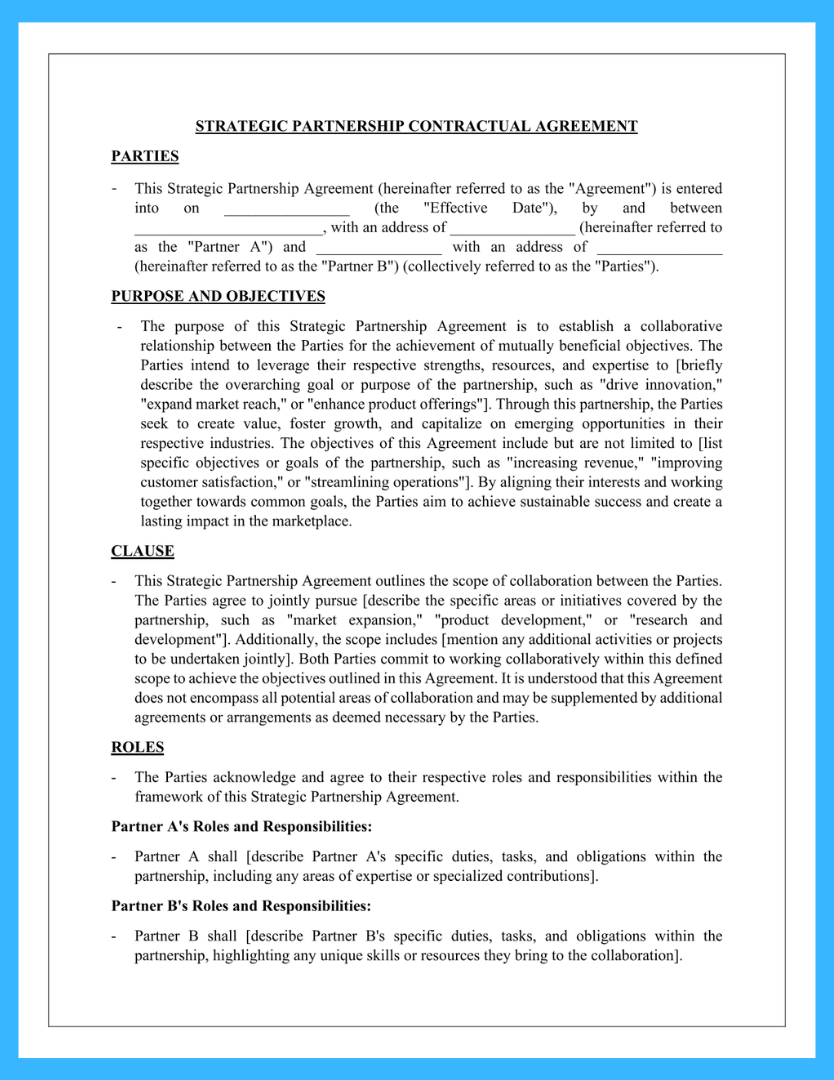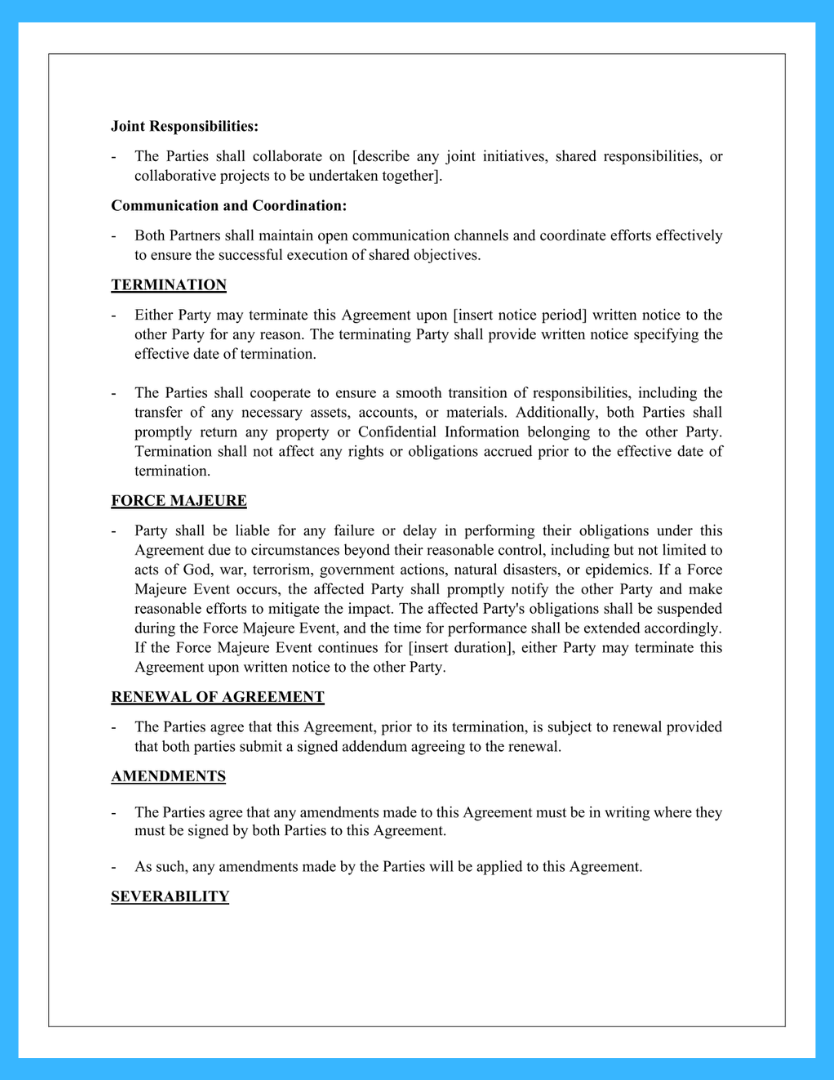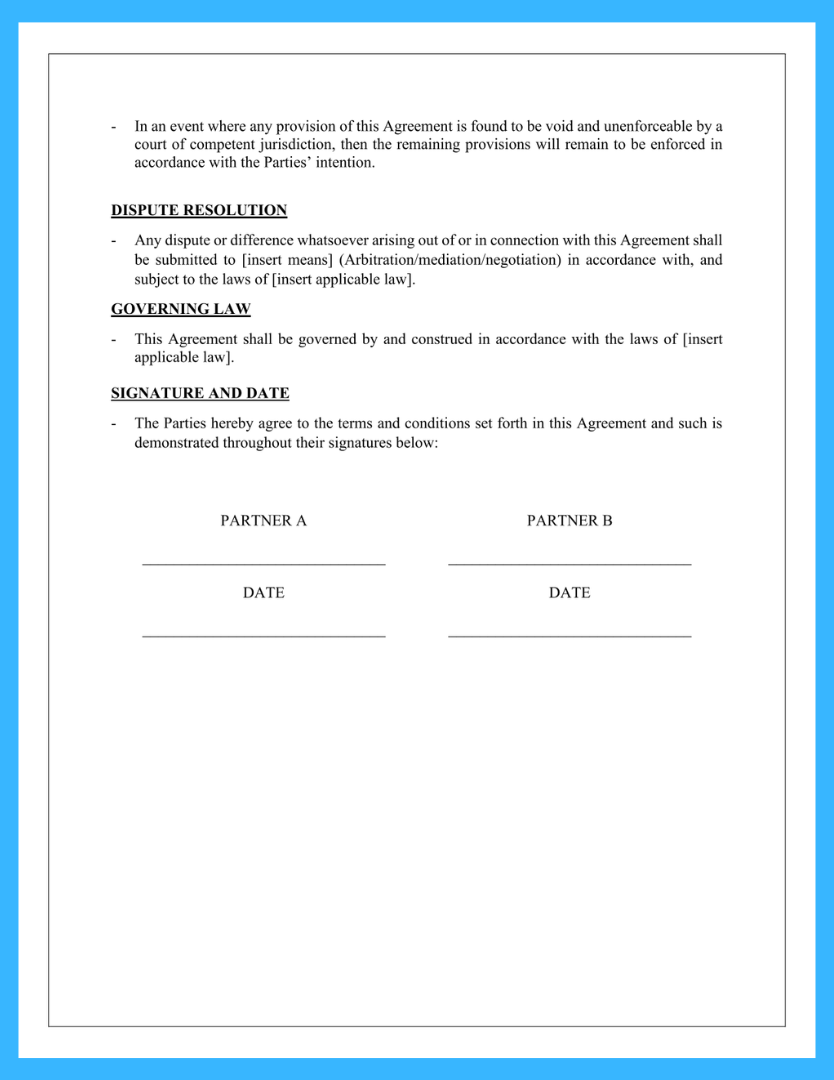Strategic Partnership Agreement: What to Know + Free Template
A strategic partnership agreement formalizes a collaborative relationship between two companies to share resources and expertise.




What is a Strategic Partnership Agreement?
A strategic partnership agreement is a legal contract outlining a formal alliance between two businesses to meet specific goals. These partnerships involve close, long-term collaboration where the companies remain independent but share resources, knowledge, access to new markets and customers, and more.
Strategic partnerships bring together two companies, often in different industries or with complementary offerings, to benefit from each other’s assets, strategies, and expertise. For example, a technology company may partner with a marketing firm to help bring a new product to market. In addition, an app developer partners with a hotel chain to build a custom mobile app to enhance the guest experience.
These agreements make the most sense when the potential value gained through a partnership is more significant than what each company could attain. They help reduce risk while allowing each partner access to new revenue streams, technologies, talent, and resources like distribution channels, equipment, and funding. A strategic alliance also boosts operational efficiencies, driving greater productivity and cost savings.
Careful planning is involved in identifying shared objectives. It’s essential to map out activities each party handles, quantify how investments and returns will be split, outline governance processes for decision-making, and establish rules for protecting sensitive data and intellectual property. These details are memorialized in the written contract.
At the end of this article is a free customizable template to create a solid strategic partnership agreement and align on specifics as you look to collaborate with another company for mutual benefit going forward.
Types of Strategic Partnerships
Strategic partnerships come in many forms, combining two companies with complementary strengths to accomplish shared objectives neither could quickly achieve alone. The services, resources, and value exchanged depend on the partnership type.
Strategic Marketing Partnerships
Marketing partnerships unite an expert marketing company with a partner lacking marketing capabilities. The marketing firm shares strategic advice, brand-building expertise, creative solutions, media buying clout, and other marketing assets to penetrate new markets or strengthen positioning. In return, they gain long-term revenue streams and often an equity stake.
For example, an athletic apparel startup might link with a top sports marketing agency to leverage existing relationships with teams and athletes to lend credibility and reach consumers. Using a professional athlete’s name and likeness on products would be a typical value exchange.
Strategic Supply Chain Partnerships
Supply chain partnerships integrate functions like manufacturing, warehousing, transport, and logistics between companies. They maximize efficiency through resource and data sharing while reducing costs.
An example of a strategic supply chain partnership is a manufacturer teaming up with a third-party logistics provider (3PL) to store and distribute goods rather than building their own warehouses. The manufacturer benefits from the 3PL’s infrastructure and expertise. In exchange, the logistics firm locks in a reliable long-term client.
Strategic Technology Partnerships
A strategic technology partnership allows companies to share intellectual property (IP), leverage complementary technological innovations, save on R&D costs, and accelerate time-to-market. One firm provides hardware, software, a platform, or other tech; the other provides a channel to market, manufacturing capabilities, capital, or subject matter expertise.
For instance, a digital health startup might partner with a wearable technology company to integrate advanced heart rate tracking into a new medical app for remote patient monitoring. The startup builds the software while the wearables firm supplies the devices.
Strategic Financial Partnerships
Financial partnerships provide easier access to capital in return for sharing future profits. Often, a financial group or VC firm will infuse a startup or smaller company with growth capital to scale the business. Beyond just financing, these partnerships provide invaluable mentorship, industry contacts, and credibility.
A VC may take a 40% stake in a mobile gaming studio building a promising new augmented reality app in return for $2 million in seed funding to speed up development and marketing efforts. The startup studio retains majority control while benefiting from the VC’s business expertise and investor connections to proliferate.
Strategic Integration Partnerships
In an integration partnership, two companies might merge operations, coordinate primary functions like sales or service delivery across business units, or deeply interweave systems and processes to enhance performance. Companies integrate to reduce costs, improve productivity and decision-making, consolidate overlapping roles, and strengthen competitive positioning.
One example would be two real estate agencies in the same market joining forces, combining agent resources, leveraging unified data and analytics, and creating efficiencies across administrative functions. Consolidating overlapping capacities allows for better competition against dominant regional agencies.
Joint ventures take integration even further, with two companies essentially pooling resources and expertise to create an entirely new entity for a finite period of time. These special purpose vehicles (SPVs) allow strategic focus on a specific opportunity neither could undertake alone due to high risk or resource requirements. Partners contribute equity, assets, employees, and governance to launch the temporary new startup-like venture.
What to Include in a Strategic Partnership Agreement
A strategic partnership agreement codifies the terms of engagement between two allied companies. Drafting a thorough contract upfront aligns expectations for roles, responsibilities, resource and knowledge sharing, decision-making, financial considerations, intellectual property, and more.
While agreements vary based on the situation, several standard sections appear in most formal strategic partnership agreements.
Party Information
Identifying the two entities entering the partnership provides the necessary context upfront, including full legal names, locations, industries, and principal contacts. Outlining each party’s existing operations and offerings frames their respective strengths and how they stand to benefit mutually. Documenting company structures, capabilities, assets, areas of expertise, and number of employees ensures proper strategic alignment by capturing the relative size and scope of each organization.
Services Provided
This section details the specific services, resources, IP, or value each company will provide to the other during the partnership term. Delineating individual contributions minimizes potential confusion and ensures equitable arrangements commensurate with agreed-upon compensation.
For a technology partnership, this might entail detailing collaborative development initiatives, licensing agreements granting access to proprietary tools or platforms, exclusively shared tangible/intangible assets, personnel resources allocated, and allocation of expenses. Itemizing responsibilities makes accountability unambiguous. Quantifying levels of access and effort for each deliverable provides helpful clarity.
Payment Terms
Payment terms outline how parties will be financially compensated for their participation and contributions per the services provided. Standard options include revenue shares, royalties, upfront licensing fees, usage fees based on volume metrics like API calls or downloads, and equity stakes granting shared ownership. Defining terms incentivizes upfront effort for all sides and enables tracking ROI accountability.
Spelling out exact calculations for determining quarterly/annual payments, and specifying payment methods, investment schedules, usage reporting cadences, and reconciliation procedures provides essential clarity for smooth financial operations.
Partnership Structure
The formal agreement should define the oversight structure governing the strategic partnership, detailing processes for administration, decision-making, conflict resolution, change requests, and more. This provides invaluable clarity on authority, accountability, and ongoing operations.
For example, the creation of a joint steering committee with executives from both sides guiding significant decisions may be prudent. Outlining routines for communications, progress reviews, budget approvals, and escalation procedures prevents downstream surprises. Detailing routines for new service requests or dispute mediation outlines how to navigate future growth.
Agreement Duration
Are the terms locked in for six months? Five years? Ongoing until terminated? Defining a set initial partnership duration puts an explicit timeframe around baseline expectations, milestones, and responsibilities while allowing flexibility for extensions.
Building in periodic quarterly checkpoints to revisit the arrangement keeps engagements effective long-term as company priorities shift. Enabling automatic 1-year renewals absent a 90-day written termination notice allows the relationship to continue smoothly.
General Terms
Standard legal clauses around confidentiality, allowable modifications, early termination triggers, liability limitations and more protect both parties. For example, defining the narrow reasons to exit such a partnership early without penalty- like bankruptcy, illegal activity proven in court, or multiple unremedied contract breaches after written notice – minimizes messy breakups later.
Boilerplate language also covers governing laws, enforceability, severability, disclaimers of warranties, and limitations of liability. Ensure proper venue identification and procedures for legal notice issuance between the parties.
Signatures
The final, essential element is the official signature block for all parties to e-sign the agreement. Streamline contract execution with Signaturely to enable remote, legally valid e-signatures from anywhere in minutes rather than playing email tag with paperwork. Once signed, Signaturely provides centralized access to the fully executed agreement for reference when questions arise.
Download our free example
Strategic Partnership Agreement Template
We’ve got your back here at Signaturely, and we’re ready to help make stress-free contracts a reality. Forget the confusing paperwork and overwhelming legal jargon – get easy, breezy contract templates in minutes with our free template.
Benefits of a Strategic Partnership Agreement
Strategic partnerships deliver immense value, but realizing the full potential requires clearly capturing expectations, contributions, terms, and protections in an agreement.
Key benefits of properly structuring strategic partnerships include:
- Reduces Execution Risk: Explicitly defining business objectives, precise workstreams, specific deliverables, clear timelines, shared management procedures, and key performance indicators to track progress institutes guardrails and processes to smooth operations. This prevents scope creep or misaligned activities across collaborating yet still independent entities. Defining oversight routines and planning for roadblocks proactively mitigates surprises.
- Builds Trust & Accountability: Radical transparency into expected contributions from all parties, exact compensation formulas, ownership splits for jointly created assets, and exit considerations establish equitable alignment. Determining processes for usage metric tracking, progress reviews, change approvals, and conflict resolution builds trust by codifying accountability.
- Enables Access to New Markets and Revenue: Combining complementary capabilities, assets, relationships, infrastructure, and expertise can open doors to previously untapped channels, customer segments, and income streams. Allocating resources strategically based on each partner’s strengths accelerates expansion. Formal alignment grows the pie for all involved through pursued synergies.
- Lower Costs: Economies of scale minimize duplicated efforts around operations, strategy, infrastructure, and expenses. The efficiencies and pooled leverage generated allow partners to consolidate fragmentation and optimize spend across sales, marketing technology, manufacturing, distribution logistics, and more that is redundant pre-partnership. Shared resources directly translate to bottom-line savings.
- Drives Innovation Through R&D Initiatives: Collaborative development marrying unique perspectives, distinct skill sets, niche tools, and an infusion of additional brainpower fuels creative new ideas. Partners can undertake ambitious innovation investments and transformative projects together supported by aggregated resources that would prove too risky or substantial alone. These compound capabilities deliver cutting-edge products, advanced services, and next-gen tech leaps.
- Increases Competitive Advantages: Expanding networks, combining market share, integrating infrastructures, and bundling complementary offerings enhances differentiation and efficiencies against sector rivals lacking comparable scale advantages. Partners can leverage merged resources to outmaneuver the competition.
- Strengthens Competencies: Exchanging proprietary processes, insights around customer pain points, emerging tech expertise, creative design thinking, and proven best practices build well-rounded capabilities across collaborators. Strategic training investments groom well-aligned talent. The sum becomes greater than its parts.
- Provides Legal Protections: Standard contract clauses around confidential data protection, intellectual property considerations, preferential customer retention post-exit, allowable modification procedures, defined termination triggers, and liability limitations safeguard businesses entering vulnerable strategic alignments where significant risk accompanies the substantial reward.
- Centralizes Critical Documentation: Consolidating purpose, terms, directives, procedures, and specifying contributions provide a centralized unified playbook governing complex initiatives. This defuses potential confusion from miscommunications or memorable differences across versions stored in emails or files. Conflict resolution becomes streamlined via established mediation protocols.
Capturing the purpose, structure, and nuances guiding strategic partnerships in writing creates alignment for success.
Tips for Pitching a Strategic Partnership
Once you’ve identified a company that complements your strengths and aligns with your vision, pitching the partnership opportunity requires thoughtful positioning.
Tips for effectively pitching strategic tie-ups include:
- Lead With the “Why”: Connect the collaboration to shared goals and each party’s motivations before detailing the “what” and “how.” Demonstrate a deep understanding of every executive’s and decision-makers’ underlying interests across the potential partner organization early when framing the mutual benefits, so you can establish receptivity.
- Quantify the Market Opportunity – Back statements with complex market data, customer insights, growth metrics, and financial modeling. This analysis should substantiate the revenue potential justifying combined investment.
- Specify Tangible Resource Contributions from Both Parties: Move beyond vague generalizations around synergies by outlining precise complementary assets (e.g. distribution infrastructure, manufacturing facilities, content libraries), specialized skills (e.g. talent, design resources), proprietary processes, software platforms/tools, relationship networks, and other competencies you expect each collaborator to leverage in the partnership.
- Propose Clear Success Metrics – Define specific measurable targets covering critical areas like customer/revenue growth, cost efficiencies, utilization of assets, risk mitigation, and realization of financial projections. Setting quantitative expectations backed by routinely collected metrics ensures accountability efforts on both sides.
- Have a Solid Post-Launch Plan – Demonstrate operational readiness via a detailed execution roadmap covering decision authority policies, partnership program management support resources, initial 90-day priority activities, complex change management considerations, communications procedures, scheduled progress reviews, and key milestones. This reinforces organizational commitment beyond an impromptu partnership concept.
- Outline Risks and Mitigations – Address known barriers, compatible cultures, prior history working together, expected hurdles, and how each will be managed proactively.
- Sell your Competence – Quantify prior experience structuring partnerships, executing launches, overcoming obstacles, and driving enterprise deals to reinforce confidence.
Getting the details right on strategic partnership opportunities demonstrates awareness of the critical ingredients Getting the positioning, proofs, details, and contingencies right across each pitching dimension demonstrates serious awareness of the critical ingredients necessary to deliver a mutually beneficial winning collaboration at an executive level. Blending visionary strategy with tactical planning is key to delivering a winning collaboration.
How to Create a Strategic Partnership Agreement With Signaturely
Rather than building a strategic partnership agreement from scratch and risking critical omissions, partner with Signaturely for an optimized templatized approach.
Signaturely’s strategic partnership agreement template simplifies proper documentation. Their legally binding tool incorporates all essential sections like defining services, compensation, IP protection, and exit criteria. Further, automated workflows speed up remote e-signature execution from all parties.
Centralized tagging and automated notifications through the Signaturely platform remove administrative hassles throughout the process. Their dashboard enables transparent tracking of document status and streamlines future access.
Don’t leave partnership details open to interpretation – leverage Signaturely’s purpose-built solution for creating, signing, and managing strategic business agreements with legal compliance and efficiency. Click below to get started with their free trial.
FAQs About Strategic Partnership Agreements
Strategic partnerships involve intricate dynamics between two independent companies, so questions frequently arise on deal structuring.
What’s the difference between a strategic partnership and an alliance?
The terms are often interchangeable, but strategic partnerships imply a formal, contractual joint effort around a business objective. Strategic alliances describe the alignment but may lack detailed expectations.
How do you structure a strategic partnership?
Proper structure outlines the mutual contribution of resources, connects capabilities to shared goals, defines strategic relationship dynamics for decision authority, and captures legal and financial considerations.
What is a strategic partnership example?
A typical example is a technology firm partnering with a manufacturer. The tech company gets faster product testing and production while the manufacturer gains expanded distribution for a technology they couldn’t build themselves.
What are the responsibilities in a strategic partnership?
Beyond core contributions around assets, IP, and distribution infrastructure, responsibilities include clear communication, transparency in constraints, unified vision on objectives, coordinated task management, consensus building, and accountability.
What are the risks of a strategic partnership?
Potential risks to monitor are conflicting priorities as business needs diverge over time, poor integration around workflows and systems, legal liability exposures if not adequately structured, costs exceeding projected benefits, and ineffective metrics to monitor progress.
What is the first step to pursue a partnership?
A thorough evaluation of strategic alignment around the target market, respective capabilities and weaknesses, initial value exchange potential, and leadership compatibility should guide partnership prospecting before formal discussions.
What You Need to Remember About Strategic Partnership Agreements
Strategic partnerships catalyze growth neither company could achieve individually by combining complementary strengths. However, they risk delays from mismatched expectations, disputes over IP ownership, unclear authority, and responsibility confusion without clearly defining contributions, decision processes, legal protections, and success metrics.
The time invested initially fleshing out details formalized in a partnership agreement pays dividends over the long-run collaboration through enhanced transparency, faster adaptations to market shifts, and simplified conflict resolution if challenges emerge. Don’t leave a blueprint for the partnership solely in discussion – document agreed terms in a contract.
Free Strategic Partnership Agreement Template
STRATEGIC PARTNERSHIP CONTRACTUAL AGREEMENT
PARTIES
- This Strategic Partnership Agreement (hereinafter referred to as the “Agreement”) is entered into on ________________ (the “Effective Date”), by and between ________________________, with an address of ________________ (hereinafter referred to as the “Partner A”) and ________________ with an address of ________________ (hereinafter referred to as the “Partner B”) (collectively referred to as the “Parties”).
PURPOSE AND OBJECTIVES
- The purpose of this Strategic Partnership Agreement is to establish a collaborative relationship between the Parties for the achievement of mutually beneficial objectives. The Parties intend to leverage their respective strengths, resources, and expertise to [briefly describe the overarching goal or purpose of the partnership, such as “drive innovation,” “expand market reach,” or “enhance product offerings”]. Through this partnership, the Parties seek to create value, foster growth, and capitalize on emerging opportunities in their respective industries. The objectives of this Agreement include but are not limited to [list specific objectives or goals of the partnership, such as “increasing revenue,” “improving customer satisfaction,” or “streamlining operations”]. By aligning their interests and working together towards common goals, the Parties aim to achieve sustainable success and create a lasting impact in the marketplace.
CLAUSE
- This Strategic Partnership Agreement outlines the scope of collaboration between the Parties. The Parties agree to jointly pursue [describe the specific areas or initiatives covered by the partnership, such as “market expansion,” “product development,” or “research and development”]. Additionally, the scope includes [mention any additional activities or projects to be undertaken jointly]. Both Parties commit to working collaboratively within this defined scope to achieve the objectives outlined in this Agreement. It is understood that this Agreement does not encompass all potential areas of collaboration and may be supplemented by additional agreements or arrangements as deemed necessary by the Parties.
ROLES
- The Parties acknowledge and agree to their respective roles and responsibilities within the framework of this Strategic Partnership Agreement.
Partner A’s Roles and Responsibilities:
- Partner A shall [describe Partner A’s specific duties, tasks, and obligations within the partnership, including any areas of expertise or specialized contributions].
Partner B’s Roles and Responsibilities:
- Partner B shall [describe Partner B’s specific duties, tasks, and obligations within the partnership, highlighting any unique skills or resources they bring to the collaboration].
Joint Responsibilities:
- The Parties shall collaborate on [describe any joint initiatives, shared responsibilities, or collaborative projects to be undertaken together].
Communication and Coordination:
- Both Partners shall maintain open communication channels and coordinate efforts effectively to ensure the successful execution of shared
TERMINATION
- Either Party may terminate this Agreement upon [insert notice period] written notice to the other Party for any reason. The terminating Party shall provide written notice specifying the effective date of termination.
- The Parties shall cooperate to ensure a smooth transition of responsibilities, including the transfer of any necessary assets, accounts, or materials. Additionally, both Parties shall promptly return any property or Confidential Information belonging to the other Party. Termination shall not affect any rights or obligations accrued prior to the effective date of termination.
FORCE MAJEURE
- Party shall be liable for any failure or delay in performing their obligations under this Agreement due to circumstances beyond their reasonable control, including but not limited to acts of God, war, terrorism, government actions, natural disasters, or epidemics. If a Force Majeure Event occurs, the affected Party shall promptly notify the other Party and make reasonable efforts to mitigate the impact. The affected Party’s obligations shall be suspended during the Force Majeure Event, and the time for performance shall be extended accordingly. If the Force Majeure Event continues for [insert duration], either Party may terminate this Agreement upon written notice to the other Party.
RENEWAL OF AGREEMENT
- The Parties agree that this Agreement, prior to its termination, is subject to renewal provided that both parties submit a signed addendum agreeing to the renewal.
AMENDMENTS
- The Parties agree that any amendments made to this Agreement must be in writing where they must be signed by both Parties to this Agreement.
- As such, any amendments made by the Parties will be applied to this Agreement.
SEVERABILITY
- In an event where any provision of this Agreement is found to be void and unenforceable by a court of competent jurisdiction, then the remaining provisions will remain to be enforced in accordance with the Parties’ intention.
DISPUTE RESOLUTION
- Any dispute or difference whatsoever arising out of or in connection with this Agreement shall be submitted to [insert means] (Arbitration/mediation/negotiation) in accordance with, and subject to the laws of [insert applicable law].
GOVERNING LAW
- This Agreement shall be governed by and construed in accordance with the laws of [insert applicable law].
SIGNATURE AND DATE
- The Parties hereby agree to the terms and conditions set forth in this Agreement and such is demonstrated throughout their signatures below:
PARTNER A |
PARTNER B _______________________________ |
DATE
_______________________________
|
DATE
_______________________________ |
Download Our Free Strategic Partnership Agreement Template Today
Don’t waste any more time trying to craft the perfect strategic partnership agreement template. Our simple strategic partnership agreement template is ready and ready to download in one quick, convenient click—no more complicated documents for you or your clients to fill out.
Just download, customize, and off you go!